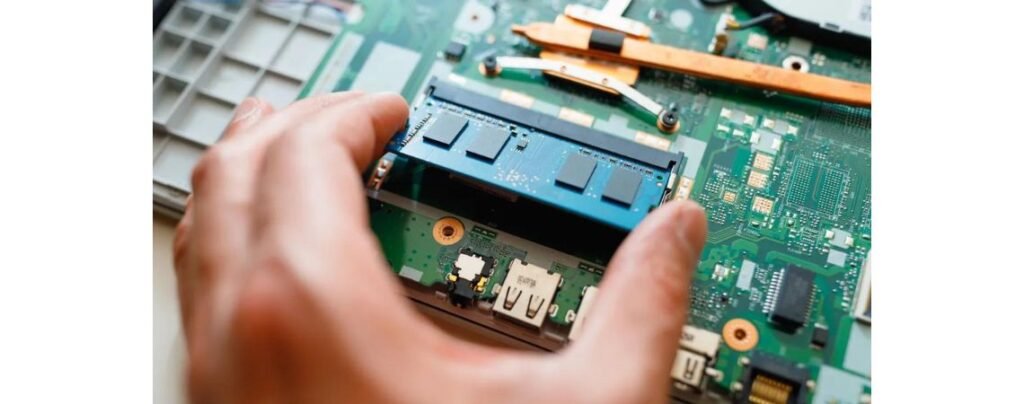
Essential Checklist for Buying a Used Phone in Pakistan
February 16, 2024
MacBook Air M3 Review 13- and 15-Inch: Apple NAILED It!
March 2, 2024RAM, which stands for Random Access Memory, is a crucial component of any computer or laptop. It is a type of temporary storage that allows your device to access and manipulate data quickly. Consider it like the short-term memory of your computer. When you open an application or perform a task, the necessary data is loaded into the computer or laptop RAM for quick access. This allows your system to perform tasks efficiently and without delays.
However, the importance of the memory module lies in its ability to enhance the speed and efficiency of your computer or laptop. With sufficient RAM, like a ddr4 laptop RAM, your device can handle multiple tasks eventually without slowing down. Additionally, it ensures smooth multitasking, faster data processing, and quicker response times.
Whether you’re browsing the internet, editing documents, or running resource-intensive applications like video editing software or games, having the best RAM for laptop or PC is essential to maintain optimal performance.
How Does RAM Affect the Speed & Efficiency of the System?
The amount of RAM in your computer or laptop directly impacts its speed and efficiency. When your device runs out of available RAM, it has to rely on other storage options like theinternal hard drive, which is significantly slower in comparison. This leads to decreased performance and can cause frustrating delays and lag.
However, when you have ample RAM, the operating system and applications have more space to store and retrieve data quickly. This means your computer can load applications faster, switch between tasks smoothly, and handle intensive processes without slowing down.

For Example ~ If you’re working on a large Photoshop project, having sufficient RAM allows the software to store all the necessary data in memory, resulting in smoother editing and faster rendering times.
In addition to speed, RAM also plays a crucial role in the overall efficiency of your device. By having enough computer or laptop memory, you can reduce the strain on other hardware components, such as the processor.
This, in turn, can help prolong your computer’s or laptop’s lifespan by preventing excessive heat buildup and reducing wear and tear on critical components.
Different Types of Computer/ Laptop RAM and Their Compatibility
There are several types of RAM available in the market, and it’s important to understand their differences and compatibility with your computer or laptop.
The two most common types of RAM in Pakistan are:
- DDR (Double Data Rate).
- DDR4 (Fourth Generation of DDR).
DDR4 laptop RAM or desktop RAM is the latest and most widely used type. That offers faster data transfer rates and lower power consumption compared to its predecessors.
To determine the type of RAM compatible with your device, you need to consider the motherboard’s specifications. The motherboard will have a specific RAM slot type, such as DDR4, which determines the type of RAM you can install. Moreover, it’s essential to consult the motherboard’s user manual or online specifications to verify compatibility before you buy RAM for laptop.
Besides the type, you also need to consider the capacity or size of the RAM modules. The capacity denotes the memory size that each module can accommodate. However, common capacities range from 4GB to 32GB, with higher capacities allowing for more simultaneous tasks and better performance. Additionally, it’s important to note that some older systems may have limitations on the maximum RAM capacity they can support.
Steps to Changing the Desktop or Laptop RAM
Upgrading or changing the computer or laptop RAM is a relatively straightforward process. However, here’s a step-by-step guide:
- Determine compatibility: As mentioned earlier, check your motherboard’s specifications to determine the type and maximum capacity of RAM it supports. This will help you choose the right RAM modules for your upgrade.
- Purchase the RAM: Once you know the type and capacity of RAM you need, purchase the modules from a reputable source. You can find a wide range of RAM options at e-commerce stores like HC Online Store. However, make sure to buy the correct type and capacity that matches your requirements.
- Prepare your computer: Before installing the new RAM, shut down your computer or laptop and unplug it from the power source. This will prevent any electrical mishaps and ensure your safety during the installation process.
- Locate the RAM slots: Furthermore, open the casing of your system to access the RAM slots. The number of slots may vary depending on your device.
- Remove existing RAM (if applicable): If you’re upgrading existing RAM modules, carefully release the clips or levers securing the modules in place. Additionally, gently remove the modules by pulling them straight out from the slots.
- Install the new RAM: Take the RAM modules and align them with the slots on the motherboard. Moreover, insert the modules at a slight angle and apply gentle pressure until they are fully seated in the slots. However, you should hear a click indicating that the modules are securely in place.
- Power on and test: Once the new memory module is installed, close the casing of your computer or laptop and plug it back in. Power on your device and check the system information to ensure that the RAM is installed properly or not.
Do’s and Don’ts for Upgrading Computer or Laptop RAM
This table presents essential guidelines for upgrading computer or laptop RAM, outlining what to do and what to avoid during the process.
| Do’s | Don’ts |
| Check compatibility with motherboard specifications | Assume compatibility without verification |
| Purchase correct type and capacity of RAM | Buy RAM from unreliable sources |
| Power off and unplug the device before installation | Install or remove RAM while the device is powered on |
| Carefully open casing to access RAM slots | Forcefully remove existing RAM modules without releasing clips or levers properly |
| Align new RAM modules properly with slots | Insert RAM into incompatible slots or in wrong orientation |
| Apply gentle pressure until RAM modules are fully seated | Neglect to ensure RAM modules are securely in place |
Troubleshooting Common Issues Related to RAM
While upgrading your RAM can significantly improve the speed and efficiency of your computer or laptop, you may encounter some issues along the way.
Well, here are a few common problems related to RAM and troubleshooting steps to help resolve them:
- Incompatibility issues – If you experience system crashes, blue screens, or your computer fails to boot after installing new RAM, it may indicate compatibility issues. Double-check that you have installed the correct type and capacity of RAM for your device. If the problem persists, try installing the RAM modules one at a time to identify any faulty modules.
- RAM not recognized – Additionally, if your computer fails to recognize the newly installed RAM, it could be due to a poor connection or insufficient power supply. Make sure the modules are firmly seated in the slots and check if any power cables are loose or disconnected. However, updating your motherboard’s BIOS to the latest version may also resolve compatibility issues.
- Insufficient RAM – If you’re still experiencing slow performance after upgrading your RAM, you may need more memory to meet the demands of your tasks. Consider upgrading to higher-capacity RAM modules or adding additional modules if your motherboard supports it.
Altogether, if you’re unsure about troubleshooting RAM issues, it’s recommended to seek assistance from a professional or consult the manufacturer’s support documentation.
Ready to take your gaming experience to the next level? Check out our comprehensive guide to selecting the best graphics card!
Conclusion
In conclusion, RAM plays a vital role in enhancing the speed and efficiency of your computer or laptop. It allows for quick access and manipulation of data, ensuring smooth multitasking and faster response times. By having sufficient computer or laptop RAM, you can avoid frustrating delays and lag while performing various tasks.

Moreover, understanding the different types of RAM and their compatibility with your device is crucial when considering an upgrade. Following the proper steps to upgrade your RAM will help ensure a successful installation. In case of any issues, troubleshooting common problems related to RAM can help resolve them efficiently.
However, investing in adequate RAM like a ddr5 laptop RAM is a worthwhile endeavor to optimize the performance of your system. So, if you’re looking to enhance the speed and efficiency of your device, consider upgrading your RAM. Visit online stores like Hafeez Center to explore a wide range of RAM options and make your purchase with confidence. Your computer or laptop will thank you with improved performance and a smoother user experience.
FAQs
How much RAM is perfect in a laptop?
For everyday tasks like web browsing, document creation, and light photo editing, 4GB or 8GB is typically suitable. However, for more demanding activities such as gaming or graphic design, you may want to consider upgrading to 16GB or even 32GB of RAM.
What are the different types of RAM?
The two most common types of RAM are DDR (Double Data Rate) and DDR4 (Fourth Generation of DDR). DDR4 is the latest and most widely used type, offering faster data transfer rates and lower power consumption.
How much RAM is perfect for gaming?
For optimal gaming performance, 16GB of RAM is recommended.
Can I add more RAM to my laptop/desktop?
Most laptops and desktops have slots for additional RAM modules. Check your manual or manufacturer’s website for upgrade options.
Where to find RAM in a laptop or computer?
RAM modules are typically located on the motherboard in slots called DIMMs (desktops) or SO-DIMMs (laptops).
Where to buy the best computer/laptop RAM in Pakistan?
If you’re looking to enhance the speed and efficiency of your device, consider upgrading your RAM from Hafeez Center Lhr.











